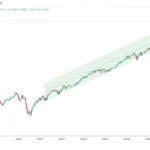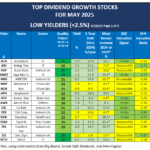1. Setting the Stage: Why AI, and Why Now?
Over recent years, artificial intelligence has evolved from niche research to mainstream investment thesis. Since the launch of ChatGPT in late 2022, companies have poured capital into AI infrastructure, tools, and applications. AI has not only sparked investor enthusiasm but also reshaped how firms across sectors deploy technology for growth and operational efficiency.
The market’s confidence in AI is reflected in major players such as Nvidia, Microsoft, Meta, and Alphabet—whose AI initiatives are central to their future prospects. Collectively known as the “Magnificent Seven,” these tech giants are responsible for a substantial share of the S&P 500’s performance since 2022
2. Nvidia: The Catalyst at $4 Trillion
A. From GPUs to AI Dominance
On July 9, 2025, Nvidia became the first public company to reach a $4 trillion market capitalization—a milestone driven by its leadership in AI data-center chips and infrastructure Year‑to‑date, its stock gained roughly 21%, and over the past 12 months it surged nearly 24%, with revenues jumping from $8.4 b to $74.3 b between 2023 and 2025 fiscal years
B. Analyst Optimism—and Risks
Analysts have been bullish. Citi recently lifted Nvidia’s price target from $180 to $190, anticipating 20% upside as AI demand grows, including sovereign AI projects and rapid deployment of its Blackwell chip architecture. While they note possible U.S. export restrictions to Asia pose risks, Citi remains confident Nvidia can manage compliance and distribution controls
UBS and Citi have flagged demand fundamentals supporting these valuations—though they caution about valuation overheating if enterprise adoption lags Reuters commentary also highlights that Nvidia’s P/E of ~34× earnings remains “modest” relative to its growth—and that a market frenzy could drive valuations toward $15 trillion should patterns repeat from the dot‑com era
C. Reality Check
While valuations are exceptionally high, Nvidia has also demonstrated consistent earnings power, resilience to export shocks, and structural leadership in the AI supply chain. Its stock price ($164.92 as of July 14, 2025) and rapid growth position it as the bellwether of the AI boom
3. Broader U.S. Investor Landscape: Big Tech and Beyond
A. The Magnificent Seven and AI Capital Flows
Companies like Microsoft ($503.32), Alphabet ($180.19), Amazon, Meta, Apple and beyond are central players in AI investment and corporate strategy Major technology investors—including Goldman Sachs—are raising price targets on Microsoft and Meta, driven by AI-related revenue growth expectations and cloud infrastructure demand
Analyst Daniel Ives from Wedbush predicts a 25% rise in tech stocks in 2025, citing reduced regulatory pressure and increased federal initiatives around AI Citi and UBS similarly advocate selective exposure to AI infrastructure names like Broadcom, Micron, TSMC, Snowflake, Oracle, asserting long-term demand fundamentals justify current valuations—while cautioning about uneven enterprise adoption
B. Smaller AI & Semiconductor Players
Beyond blue‑chip giants, investors are targeting growth and momentum among smaller AI names. Companies like Quantum Computing Inc. (QUBT) delivered staggering returns (over 3,000% in 12 months), and others like Palantir, AppLovin, Upstart, Cerence, SoundHound, and FARO Technologies are gaining attention for their AI‑driven business models and recent performance
The Motley Fool and Yahoo Finance recently enumerated Amazon and Alphabet as top rebound candidates in the second half of 2025, highlighting improving sentiment and fixed structural positioning in AI infrastructure Meanwhile, Yahoo Finance and Barron’s reported multiple analysts citing Palantir, Arm, Apple, Meta as “no-brainer” AI dip buys
C. M&A and Infrastructure Consolidation
Private equity and corporate investors are acquiring and consolidating AI-value-chain companies, particularly those with data-rich platforms or enterprise AI capabilities. M&A activity in 2025 is expected to remain robust as well-capitalized funds target firms with scalable AI IP or infrastructure value—especially if valuations soften in smaller stocks
One prime example is CoreWeave, a cloud provider backed by Nvidia and Microsoft that IPO’d in March 2025, partnered with OpenAI, and acquired Weights & Biases in March—positioning itself as a major AI infrastructure player
4. Are U.S. Investors Riding the AI Wave?
A. Retail and Institutional Momentum
Retail and institutional investors alike have piled into AI-related equities. Strong earnings (78% beat expectations in Q1) and optimistic outlooks for Q2 are fueling flows into AI names Analysts note that cautious sentiment may actually signal optimism—a contrarian bullish indicator in a tech‑led rally fueled by AI momentum plus macro tailwinds like cooling inflation and lower tariffs
Retail investors have shown growing engagement in tech sectors, supported by easy access to brokerage apps and ETF exposure. ETFs like ARKQ (Autonomous Tech & Robotics) are positioning portfolios around AI and robotics growth.
B. The Upside Potential
- Macro tailwinds may support another leg higher in tech: analysts at Sanctuary Wealth see a potential 12% rise in the S&P 500 to 7,000 by end‑2025, driven largely by AI and robotics investments Business Insider.
- Spending on AI infrastructure is projected to exceed $630 b by 2028, with hyperscalers leading with over $300 b in 2025 capital spending on AI data centers, cloud, chips, software and cybersecurity Barron’s.
- Enterprise AI adoption continues to ramp up, though at varying speeds—companies in tech sectors and large firms are early adopters, while broader SME uptake is slower but growing gradually .
C. Risks and Caution
Despite enthusiasm, risks remain:
- Valuation premiums in many AI stocks are anchored to future potential, not current earnings. The Capability Realization Rate (CRR) model highlights misalignment risk where markets may price in capabilities not yet monetized
- Regulatory and geopolitical shocks—especially around U.S. chip export restrictions—continue to pose risk. A notable example: when DeepSeek (a Chinese AI startup) unveiled a model surpassing ChatGPT, Nvidia and others lost as much as 17% in a single day, wiping out ~$593 b market cap across the sector
- Potential overconcentration in a handful of mega-cap names creates fragility. Some analysts draw parallels to the dot‑com crash if exuberance outpaces fundamentals—even though current P/E multiples remain lower than peak bubble levels
5. What Should U.S. Investors Do Now?
A. Strategic Exposure—With Discipline
- Anchor portfolios with blue‑chip AI leaders
Companies like Nvidia, Microsoft, Alphabet, and Meta offer scale, solid fundamentals, and direct exposure to AI infrastructure and cloud. Their earnings growth and dominance in hyperscale compute offer a relatively lower-risk base for AI exposure. - Allocate selectively to growth and momentum names
Mid‑cap to small‑cap AI stocks such as Palantir, AppLovin, Quantum Computing, Upstart, Cerence, or others with specific AI use cases can offer high upside—but carry higher volatility. Strategically allocating a small percentage can balance exposure and risk. - Consider thematic AI ETFs
ETFs like ARKQ and others focused on robotics, automation, and cloud/AI play allow diversified, passive investment in the AI ecosystem without requiring single‑stock selection. - Monitor M&A and infrastructure plays
Players enabling AI build-out—data centers, semiconductor fabricators, cybersecurity firms—can offer durable returns and may benefit from consolidation. Investments in CoreWeave, Snowflake, Broadcom, or TSMC‑related infrastructure may offer alternative paths to capitalizing on AI tailwinds.
B. Watch Key Metrics and Triggers
- Enterprise AI adoption rates and ROI from AI investments
- Capital expenditures by hyperscalers (Microsoft, Amazon AWS, Google Cloud)
- Semiconductor export policy changes and geopolitical tensions
- Valuation metrics: P/E, price-to-sales multiples, and relative CRR (capability realization vs price)
- Earnings surprises and guidance from AI leaders in upcoming reporting seasons
C. Guard Against Behavioral Biases
Investors must beware of herding, overconfidence, and narrative-driven bubbles. The academic CRR model warns that pricing may reflect future hopes rather than current performance—potentially inflating risk if expectations aren’t met . Furthermore, LLM-based investment recommendations themselves may embed bias toward popular tickers like AAPL or MSFT, so a measured, fundamentals-driven approach helps offset overhype arXiv.
6. Summary: Are U.S. Investors Riding the Next Big Wave?
Yes—but with caveats. U.S. investors have clearly embraced the AI boom: major corporations are investing billions, market sentiment is bullish, and valuations have surged. Key players like Nvidia have become trillion-dollar—and even multi‑trillion‑dollar—companies on the strength of AI demand . Analyst forecasts envision continued growth, especially from hyperscalers and enterprise AI infrastructure spending .
However, risks remain: valuation misalignment, regulatory volatility, geopolitical catalysts, and concentrated exposure in mega‑caps. Institutions and retail investors are best served by diversified exposure, calibrated allocations, vigilance around fundamentals, and an approach that balances upside potential with downside protection.
Performance Snapshot: Selected AI Leaders
NVIDIA Corp (NVDA)
$164.92
+$0.81(+0.49%)Today
$165.35+$0.43(+0.26%)Pre-Market1D5D1M6MYTD1Y5Yma
Microsoft Corporation (MSFT)
$503.32
+$1.63(+0.33%)Today
$500.89-$2.43(-0.48%)Pre-Market1D5D1M6MYTD1Y5Ymax
Alphabet Inc (GOOGL)
$180.19
+$2.53(+1.43%)Today
$179.45-$0.74(-0.41%)Pre-Market1D5D1M6MYTD1Y5Yma
ARK Autonomous Technology & Robotics ETF (ARKQ)
$91.86
+$3.74(+4.24%)Past 5 days
$92.40+$0.54(+0.59%)Pre-Market1D5D1M6MYTD1Y5Yma
- Nvidia (NVDA): $164.92 — AI infrastructure bellwether
- Microsoft (MSFT): $503.32 — Hyperscaler invests heavily in cloud‑AI
- Alphabet (GOOGL): $180.19 — Google’s AI priorities central to growth
- ARKQ ETF: $91.86 — Exposure to robotics, automation, AI ecosystem
Conclusion
Are U.S. investors riding the next big wave? Yes—but selectively, strategically, and with guarded optimism. AI is reshaping markets and driving growth across the Magnificent Seven and beyond. But success for investors will depend on discipline, fundamental evaluation, risk management, and a diversified lens—not just chasing the latest hype.


